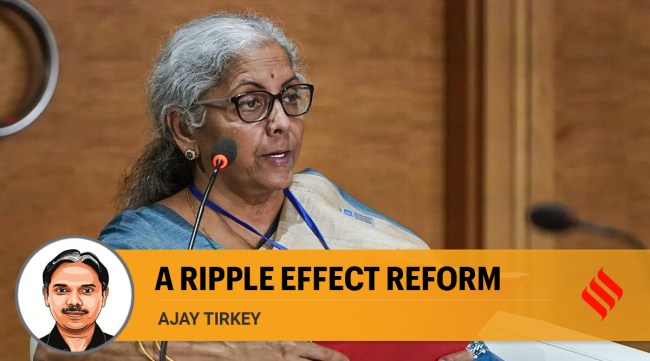Opinion Land resource management measures will impact larger economy
Ajay Tirkey writes: It will provide the right balance and float to the national economy
 Finance Minister Nirmala Sitharaman (PTI/File)
Finance Minister Nirmala Sitharaman (PTI/File) In her budget speech, the Finance Minister talked of land resource management. Any reform or initiative that strengthens land governance, impacts the economy positively and has a ripple effect across sectors.
Consider this: The computerisation and digitisation of land records, undertaken in the recent past, has enabled the e-procurement of wheat and paddy in the states through the minimum support price scheme. It is extremely convenient now for the mandi administration to make an assessment of the food crop sown and the foodgrain produced by individual farmers on the basis of khasra entries. All that the mandi administration has to do now is to plan the arrival of farmers to the mandi by staggering them village wise. And on arrival, check whether the food crop in the khasra entry matches the quantum brought to the mandi by the individual farmer. On satisfaction, payment as per the MSP is credited to the individual farmer’s account.
Most states now use computerised land records for e-procurement. While transactional efficiencies are evident, there are other benefits as well. The staggered arrival plan of farmers’ produce at the mandis can be conveniently planned on the basis of data related to total acreage under cultivation in the villages. The long queues of tractors crowding the mandis, once a common sight, is not seen these days. The ease of living of the farming community has thus been positively impacted.
Similarly, payments under the Pradhan Mantri Kisan Samman Nidhi Yojana (PM-Kisan) in the states are being done on the basis of computerised land records. Also, take the case of land acquisition for setting up an industry or infrastructural facilities like highways or railway lines. Proper and updated computerised land records are extremely essential for relief and rehabilitation.
The budget speech included three land governance initiatives. It is apparent that the initiatives are technological at their core. It is the most pragmatic way of implementing central schemes in the states. Technology cuts across geographical, regional and state policy barriers and integrates the nation by preparing all relevant sectors of the national economy to avail of the intended spin-off benefits. These three initiatives will impact the citizen and the national economy. Let us examine each of them.
First, the Unique Land Parcel Identification Number (ULPIN). In plain language, this is an Aadhaar-like identification for a land parcel or plot. Each land parcel or plot is assigned a unique identification number. And therefore, like Aadhaar, the agencies and services can use the land database from anywhere in the country to authenticate a farmer or the beneficiary’s identity for the purpose of delivery of services. The land-farmer relationship will be strengthened and authenticated. For the farmer and the individual land holder, it would facilitate and enable access to information relating to his entitlements through various means like kiosks and mobile phones. Benami and fraudulent transfers of land especially in urban areas is a big concern for states. This framework, integrated with Aadhaar, will put a check on such irregular and illegal transfers.
Second, the National Generic Document Registry System (NGDRS) — One Nation One Registration Software System — is undoubtedly a major initiative for urban property registration. It is a software application platform that facilitates online registration of immovable properties and documents as compared to the manual registration process used earlier. The entire process, right from applying for registration to paying the stamp duty and furnishing encumbrance certificates, is online. States/UTs can conveniently make use of the software. Frequent visits to various offices and institutions like banks and local bodies are not required anymore. Utility bills from local bodies and encumbrance certificates from banks are now submitted online. It is only at the time of the final execution of the registration document that the physical presence of the buyer and seller is mandatory as per Section 32A of the Registration Act. Since the processes are online, there is a higher degree of transparency in the transaction of these properties which reduces disputes and fraudulent transactions as well. NGDRS, therefore, is a major convenience for buyers and sellers of immovable property. It cuts into the costs, time and processes in registration drastically.
The third initiative is transliterating the land records in any language under Schedule VIII of the Constitution. The objective is to break the linguistic barriers in land records. Presently, land records are largely in regional languages. These linguistic barriers need to be overcome in order to open up the national economy. A prospective property buyer from Maharashtra should conveniently get access to land records of Tamil Nadu in his language. It is time that all forms of unintended barriers, including linguistic ones, which impede economic growth, be dismantled.
To conclude, the budget speech has underscored the significant role land resource management and governance is expected to play in the resurgence of the national economy in the years to come. It has strengthened the belief that the use of technology for land governance is pragmatic and a strategically convenient and acceptable approach when states are implementing schemes. And it has also emphasised that reformative land governance initiatives will positively impact and benefit the citizen as well as various other sectors of the economy in more ways than one. Land resource management and governance, like the keel of a ship, will provide the right balance and float to the national economy despite one of the worst economic downturns induced by the pandemic. How smooth the sail will be will depend on how readily and effectively states take up the land governance initiatives.
This column first appeared in the print edition on March 18, 2022 under the title ‘A ripple effect reform’. The writer is Secretary, Department of Land Resources, Government of India. Views expressed are personal.






